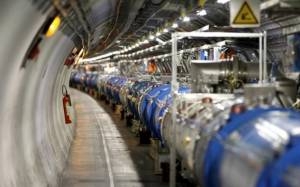Вход / Регистрация
22.12.2024, 19:08
Главная » 2015 Июнь 4 » Beefed-up atom smasher up and running again in search for dark matter
10:26 Beefed-up atom smasher up and running again in search for dark matter |
 Scientists have successfully restarted the world's biggest particle collider after a two-year shutdown, with the upgraded atom smasher now producing almost double the collision energy of its first run. The European Organization for Nuclear Research, or CERN, said Wednesday the Large Hadron Collider will now run around the clock for the next three years. The collider underwent a $150 million upgrade after its first run, which produced results that helped confirm the existence of an elusive subatomic particle, the Higgs boson, a discovery that produced two Nobel prizes in 2013. CERN's director, Rolf Heuer, said physicists hope the new run might lead to discoveries that could help "explain remaining mysteries such as dark matter.” The LHC, located in a 16.8-mile tunnel beneath the Swiss-French border, is now smashing together protons at 13 trillion electronvolts. Nobody knows quite what the LHC might reveal with its new particle collisions — mini-versions of the Big Bang primordial blast that brought the universe into being 13.8 billion years ago — but scientists hope it will produce evidence of what has been dubbed "new physics.” This concept includes "dark matter,” thought to make up some 96 percent of the stuff of the universe while being totally invisible, and super-symmetry, or SUSY, under which all visible particles have unseen counterparts. "The only thing we really know is that there is ‘new physics’ because the model that we have is not complete,” said Luca Malgeri, a scientist working at the European physics research center CERN. "It might be linked to dark matter or it might not. It might be linked to something totally new.” If there is a particle missing from current knowledge of the building blocks of the universe, CERN scientists hope that it might be spotted, even fleetingly, in the debris of the billions of collisions, just as the Higgs boson was. The first results might come early, Malgeri said, because the LHC already searched for smaller particles on its previous run, and a bigger particle might show up quickly, if high energy collisions are the key to its existence. It may have extremely weak interaction with other forces, which might explain why it had never been observed before. The CERN scientists would hope to detect any dark matter by noticing that some energy was missing after the collision, which would betray the existence of such a particle, Malgeri said. If the hoped-for particle is only created very rarely, it may take many more collisions to find it, which is why the number of collisions — the LHC's "luminosity” — will increase over the next three years until it is 10 times as bright as on its first run. Whether anything will be observed, however, is anybody's guess. "This is the million dollar question," Malgeri said. "We are wide open. After the first run of the LHC, all possibilities are equally probable for new physics." |
| Категория: Science | Просмотров: 1145 | |
| Всего комментариев: 0 | |



